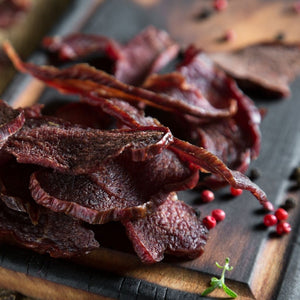Beef jerky has a long history in most cultures. Today, people consider jerky a convenient and delicious snack, but travelers once used it on long journeys as their primary food source. It comes in different flavors, textures, and types.
Ahead, we broke down everything you need to know about jerky. In this ultimate beef jerky buying guide, you’ll learn more about jerky and its history, in addition to how it’s made.
Nutrition
Jerky has a high protein content and limited carbohydrates, making it an excellent choice for keto diets. Homemade jerky is better for you since it will have a lower salt content than commercially produced jerky.
It also contains plenty of nutrients like zinc and iron, making it an excellent snack for activities like hikes. This is likely what made jerky essential for people centuries ago, when they had to travel long distances on foot.
History of Jerky
Jerky is a food preservation method that dates back thousands of years. Drying meat and seafood could preserve food before the advent of refrigeration. Back then, people used jerky as a staple, but today, it’s primarily a convenience.
Historically, “jerky” described thin strips of meat that had been salted and dried in the sun. This process dates back to the Inca empire, when people would bring jerky along on hunting trips. For many different cultures, jerky has been a staple of nomadic tribes for ages.
Preservation Methods
Traditionally, people made jerky with salt to prevent bacteria growth, but now, we use various preservatives. Commercial jerky productions use chemical preservatives. Smoking is the traditional method, as it adds flavor to the meat while it dries.
We still mainly use salt as the preservative, so if you’re incorporating jerky into a keto diet, you should pay attention to your sodium intake. However, it’s a fantastic source of protein.
Like salt, vinegar and citrus kill food-borne pathogens as jerky dries. While jerky only uses salt, other variations of cured meats, like biltong, use vinegar along with salt.
In industrial settings, people use other chemical preservatives, such as sodium nitrate, to cure jerky.
How Jerky Is Made
Jerky is dehydrated meat with the fat trimmed off. The meat sits under low heat, and moving air dries out the seasoned beef. If you were trying to make jerky at home, you could turn on your oven to a low setting and leave the door cracked to allow it to circulate. Industrial environments use large low-temperature ovens with fans to distribute air, as well as exhaust systems to remove moisture.
Even though jerky is a shelf-stable food, it requires proper moisture. For this, companies often package jerky in resealable plastic bags with small, oxygen-absorbing packets—this helps prevent the fat from oxidizing.
Texture
Altering the moisture content in jerky affects the texture. Depending on your preference, you can find jerky in various textures, ranging from extremely chewy to tender. These are three typical textures:
- Old Fashioned — Jerky lovers describe the old-fashioned jerky style as "cowboy jerky"; it’s typically very tough and salty.
- Traditional — Traditional jerky is the most common, thanks to its mild texture. It’s not too soft and not too tough, and most consumers prefer this style.
- Soft & Tender — Not as dry as traditional; this is the most tender version of jerky.
Flavors
Extremely versatile, anyone can make jerky from any meat, but beef is the most common. Achieved with a marinade or through smoking, you can find jerky in tons of different flavors. Some of the most common include:
- Original smoked
- Hickory smoked
- Jalapeño
- Teriyaki
- BBQ
Like a charcuterie plate, you can even try pairing different flavors of jerky with various cheeses.
Jerky Pairings
Pairing jerky and cheese together is perfect for a casual get-together, like a picnic, hike, or tailgate party. Here are some cheese and jerky combinations you can try:
- Gouda — Gouda is famous for its rich caramel flavor. The slight sweetness will help complement a spicy jerky, like teriyaki, jalapeño, or smoky BBQ.
- Asiago — Asiago is a mild and buttery cheese. Pair this cheese with a BBQ or Hickory smoked jerky.
- Swiss — Mellow and nutty, Swiss is an excellent cheese to pair with a smoky jerky.
- Muenster — Soft, creamy, and salty, Muenster is a delightfully mild cheese that would go well with an original smoked flavor.
- Havarti — Havarti starts mild and creamy but ends with a bite. Match it with a smoked jerky flavor.
Jerky is an extremely versatile food that you can find in most cultures around the world.
Biltong vs. Jerky
Originating from south African countries, biltong is a dried and cured meat similar to jerky. Air drying is the traditional method of production, but recently, people have turned to electric ovens. Even though the taste and process may differ between jerky and biltong, they are both spiced dried meats made from various animals. Here are the main differences between biltong and jerky:
- Biltong is usually cut thicker than jerky due to the slower drying time. This is because of the lack of moisture in arid climates.
- People use vinegar alongside salt to cure the meat, while jerky typically only uses salt.
- People often smoke jerky and include sugar additives; this is not the case for biltong.
Meat Cuts
The ultimate beef jerky buying guide wouldn’t be complete without discussing the best cuts of meat for beef jerky. The top three best cuts come from the back leg or round. Check out the breakdown below:
- Eye of round — Eye of round is a lean cut of meat taken from the center of the back leg. The round is an excellent cut for jerky since there is a minimal trimming of fat. Additionally, the grain runs down the length, and it’s generally inexpensive.
- Bottom round — Bottom comes from the upper muscle of the leg, and even though it’s the least tender of the rounds, it still makes a great jerky due to its flavor.
- Top round — The tenderness of the top round falls somewhere in between the eye and the bottom.
Online Ordering
You can easily buy beef jerky online with Sohnrey Family Foods! If you’re looking to order protein-packed snacks, take a look at our products! We have nuts and spreads you can include in your pantry.



Wisco Meats - November 08, 2024
Fantastic guide! This covers everything anyone would need to know about beef jerky, from its rich history to practical buying tips. I really appreciate the detailed breakdown of flavors, textures, and even pairing ideas with cheese—such a creative addition for a unique snacking experience! The comparison with biltong and the recommended meat cuts for jerky add valuable insights for both new and seasoned jerky fans. Thanks for such an informative read, Sohnrey Family Foods!